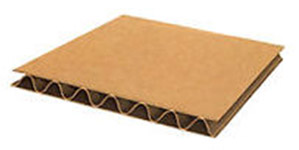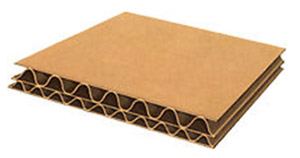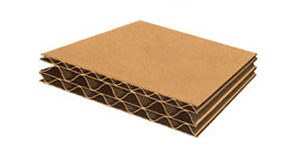 |
Corrugated Materials |
 |
| |
| TYPES OF CORRUGATED MATERIALS |
Single Wall Corrugated
A corrugated medium with a linerboard facing adhered to both sides. It is also referred to as “Double Face”. This popular and versitile 3-ply construction is converted into a wide variety of containers and packaging components. This type is the most popular, and offers a wide range of strengths. |
 |
|
|
|
Double Wall Corrugated
Two corrugated mediums (B & C Flutes) with a linerboard facing adhered between them and to both sides. This 5-ply construction is most applicable for packing heavy items where high rigidity and protection is required. It offers extra padding and strength, which is suitable for stacking heavy items. |
 |
|
|
|
Triple Wall Corrugated
Three corrugated mediums and four linerboard facings (2 layers of C-Flute and one layer of B-Flute). This 7-ply construction is used where large container sizes are involved, such as pallet packs. It is very strong, crush resistant, and is excellent for storage and transit.
|
 |
|
| TYPES OF FLUTING |
The “Flute” refers to the wave shaped cardboard reinforcement that make up the board’s core. This is the board’s corrugation.
Flutes come in several sizes, known as flute profiles. The standard profiles range from A-flute (the largest) to F-flute and below (microflutes).
A-flute = 33 flutes/linear foot (1/4” thick)
B-flute = 47 flutes/linear foot (1/8” thick)
C-flute = 39 flutes/linear foot (11/64” thick)
E-flute = 90 flutes/linear foot (1/16” thick)
F-flute = 128 flutes/linear foot (1/32” thick)
Generally, larger flutes provide greater strength and cushioning, while smaller flutes have better printability and foldability.
Flute profiles can be mixed and matched within the same piece of combined board, to manipulate printability, compression strengths, cushioning strengths and the total thickness of the board. For instance, CE double wall gets its durability from its C-flute layer, while the E-flute gives it a smoother printing surface.
A-Flute
A-Flute, the original flute, is the highest flute size, and therefore, when combined with an inner and outer facing, is the thickest. With 36 flutes to the foot, A-Flute makes the most of corrugate cushioning and stacking properties for fragile and delicate items. Because A-Flute offers excellent stiffness qualities and short column crush resistance, it has application across a broad range of customer uses. Its structure is 36 Flutes / Foot, or approximately ¼” thick.
B-Flute
B-Flute, the second flute size adopted by the corrugated industry, has lower arch heights than A-Flute and more flutes per foot (50). This means that the medium contacts and supports the liners at a greater number of points, providing a stiff, flat surface for high quality printing and die cutting and with excellent crush resistant properties. B-Flute is also preferred for high speed, automatic packing lines and for pads, dividers, partitions and other forms of inner packing. Complex die cuts and beverage trays are excellent applications for B-Flute as are can cases, wrap-around blanks, glass-to-glass packs and slip sheets. B-Flute is generally combined with light weight liners but can be used with heavier facings if the need arises. |
- 49 Flutes / Foot
- good puncture resistance
- less space consumed in warehouse
- uses: canned goods, displays
|
 |
|
| C-Flute
C-Flute came along next to split the difference between A and B Flutes. With 42 flutes per foot, it's thinner than A-flute, thicker than B, and offers good cushioning, stacking and printing properties. C-Flute is by far the most widely used flute size. An estimated 80% of today's corrugated containers are made of C-Flute board. |
- 41 Flutes / Foot
- good stacking strength
- good crushing resistance
- very common
- uses: glass, furniture, dairy
|
 |
|
| E-Flute
E-Flute has the greatest number of flutes per foot at 94 which gives it the greatest crush resistance and the flattest surface for high quality printing applications. The thin board profile of E-Flute (it is one-fourth the thickness of C-Flute) reduces box size and saves storage space. Because of its thin profile and excellent cushioning properties, E-Flute can often substitute for conventional folding cartons or solid fiber containers. Examples of E-Flute applications include boxes for cosmetics, fragile glass and ceramic items and delicate instruments. Another growing end-use is for pizza boxes where the retailer wants a cost effective container with good graphics and excellent product protection. |
|
95 Flutes / Foot
light weight
strong alternative to paper board
superior printing surface
excellent for custom die cut boxes
uses: displays, point of purchase boxes
|
 |
|
F-Flute
the newest flute, is just a little more than half the thickness of E-Flute and is the newest growth segment in the corrugated industry. The idea behind the new flute, originally developed in Europe, is to make packages with lower fibre content.
With F-Flute, converters can reduce the total amount of fibre in the packaging, thereby creating a more rigid box with less solid waste going into landfills. In Europe, F-Flute is being used for specialty packaging, point-of-purchase displays, jewelry and cosmetic packages and shoe boxes. In the U.S., the McDonald’s Big Mac clamshell in F-Flute has received great attention. Dairy Queen, too, is using the F-Flute clamshell for its “Ultimate sandwich” and its hot dogs.
128 Flutes / Foot
1/32"
|
| |
| |
|
|
 |
|
 |
|
|